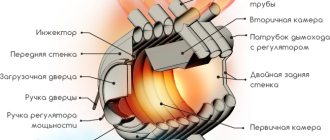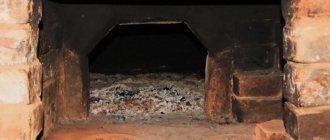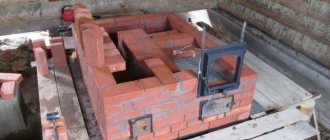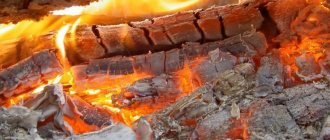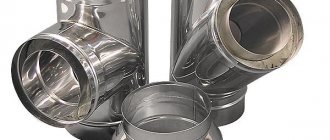With rising energy prices, more and more people are seeking to obtain as much energy as possible from sources previously considered waste. In this case, used oil, household waste, and old car tires are considered as fuel.
Today we will talk about how to build a sawdust stove inexpensively and with your own hands, and it will be a unit that works on the principle of long-term combustion.
After all, it will not be a secret to anyone that in our country there are regions where wood chips and sawdust can be used for heating for practically nothing, except for the cost of their delivery.
Smaller area – less heat
There are long-burning stoves with connected water and air circuits. Thanks to this, a sawdust stove can heat a fairly large area.
In the article about heating stoves for greenhouses, we have already considered a do-it-yourself version of a sawdust stove, but this version of the stove is capable of heating a relatively small area, and this is not due to the lack of a water or air circuit, but to the small area where hot gases are used.
The figure shows drawings of this furnace.
Sawdust stove from a 200 liter barrel
Furnace heating area
As you can see, when fully loaded, the thermal area of the furnace is approximately 1/3 of the total area . In the figure, this area is highlighted with red shading.
With this arrangement, there is a loss of thermal energy escaping through the chimney. Of course, you can try to get as much heat as possible by increasing the length of the chimney through the heated room. But this is not entirely rational, and in some cases it is simply impossible due to the design features of the room and its area.
This long-burning sawdust stove is good for its simplicity, because by and large it can be made within a few hours from scrap materials.
Design and operating principle
A long-burning stove does not look like a traditional potbelly stove, as we imagine it. In addition, it is not mass-produced by any manufacturer, and its design is entirely the achievement of various craftsmen. Most of all, the new potbelly stove resembles a round metal stove - a “slobozhanka”, but differs from it in the way it burns fuel. Sawdust is used as the latter, and here's why:
- heating with a potbelly stove powered by sawdust and wood chips will be inexpensive due to the availability of such fuel;
- compressed sawdust burns out for a long time; one load will last from 6 to 10 hours of operation of such a heat generator.
The stove has a vertical configuration and consists of two cylinders, the smaller one is installed inside the larger one. The simplest option is 2 barrels with a capacity of 200 and 100 liters. Under the small barrel, which acts as a combustion chamber, there is space for the ash box, which is removed through an opening in the lower part of the large barrel. To supply air to the firebox, the design of the potbelly stove provides a round hole made in the bottom of a small cylinder. It enters through the slightly open ash pan. The top of the housing is tightly closed with a lid, and a chimney pipe is installed on the side between two stiffening ribs.
There is no special wisdom in how long-burning potbelly stoves operate. First, a cone is inserted vertically through the open top cover into a round hole made in the bottom of the firebox. Then the combustion chamber is filled to the top with sawdust, which is compacted tightly. The cone is carefully removed, the top lid is closed and you can start igniting. To do this, take out the ash box, put wood chips, splinters, and small wood in it and set it on fire. The box is inserted into place without sliding it all the way in to leave a gap for air. Details of the process are shown in the video:
Under the influence of the draft created by the chimney, the compressed sawdust begins to slowly smolder, and the long-burning stove enters operating mode. Combustion products leaving the firebox heat the walls of the barrel and exit through the chimney pipe. This method of heat transfer makes it possible to remove a significant part of the heat from the flue gases, increasing the efficiency of the heat generator (efficiency) to 40-50%. In this case, the duration of work from one load can reach 10 hours, as mentioned above. In addition to these advantages, a sawdust stove has others:
- low cost of production;
- ease of installation, installation of a potbelly stove consists only of installing a chimney with satisfactory draft;
- low requirements for fuel quality;
- energy independence.
The disadvantage of a potbelly stove is that you cannot add fuel “on the go” until the previous portion of sawdust has completely burned out. Again, like any iron stove, the unit heats only the room in which it is located. But this drawback can be corrected by adding a water circuit and connecting it to several radiators located in other rooms. Then you will get complete heating with sawdust for a small private house or cottage.
Solving the problem - circuit design
But today we are interested in a long-burning sawdust stove, which can be used to heat rooms as large as possible.
Of course, you will need to install a water or air circuit, but first let’s solve the question: is it possible to increase the thermal area in a stove of this type without increasing the length of the chimney?
External circuit device
The first one shows a long-burning stove with an external smoke circuit. The device completely replicates the previously presented sawdust stove. The only changes are the circuit through which the hot flue gases pass and the lower position of the chimney.
The first one shows a stove with an external smoke circuit. The device is completely identical to the previously presented oven. The only changes are the circuit through which the hot flue gases pass and the lower position of the chimney.
As you can see, the changes made it possible to significantly increase the thermal area of the long-burning furnace without increasing the length of the chimney. The volume of the firebox remained unchanged.
As you can see, the changes made it possible to significantly increase the thermal area of the furnace without increasing the length of the chimney. The volume of the firebox remained unchanged.
Internal contour of a sawdust stove
In the second case, the internal circuit is installed inside an existing furnace. The thermal area has also increased. The only drawback of this installation is the reduction in sawdust loading volume.
But there is also an advantage: setting up such a circuit will not be difficult; the only thing required is installing a 200-liter barrel of a smaller diameter inside and rearranging the chimney.
As you can see, a small modification will significantly increase the efficiency of using such a seemingly simple stove.
Boilers with top chamber placement
There are also boiler models that operate in exactly the opposite direction. Folk craftsmen designed one gasification chamber at the bottom and another at the top. These types of boilers are not yet so popular, but their advantages are already obvious:
- The system operates on natural draft using a new solution in the design of air channels.
- Eliminates the use of electricity.
- "Inverted" design.
The bottom line is that the pyrolysis gas enters the upper chamber and combines with secondary air. Discharged air enters the boiler through the lower hole, combines with oxygen, and forms a medium for the oxidation reaction. The flammable gas burns in the lower chamber and releases heat to the water. The special hardened steel of the boiler allows clear smoke to exit the chimney.
New system on old principles
Sawdust boiler with a register for connecting to a radiator heating system
But that's not all. A homemade sawdust stove allows you to create even more efficient designs.
The picture shows a long-burning boiler with the ability to connect to a water heating system. What’s remarkable is that the boiler can be made with your own hands; it works on sawdust, small wood chips and various household waste. But of course, first of all, it is designed to work on sawdust.
Cover with blower
Upon closer examination, our readers will notice some similarities between this boiler and the Bubafonya stove. But it is not so.
The pipe passing through the lid, although it is a blower, does not have the shape of a piston and is completely motionless when the boiler is operating. This picture shows a fully charged boiler. As you can see, the pipe is recessed almost completely inside; in a “bubafoni” it would protrude significantly from the boiler.
Operating principle and design of the furnace
A long-burning boiler differs from other solid fuel heating devices in that it is not combustion that occurs inside, but smoldering, which releases enough heat to provide one or two rooms. To create the smoldering process, the fuel is compacted so that a minimum of air remains between its particles, since oxygen increases the intensity of the process with enormous heat release.
In this case, fuel is quickly consumed and will need to be reloaded. Such boilers do not bring any savings, and excess heat will escape through the chimney and will not be used for its intended purpose. A long-burning boiler uses the energy released during smoldering and is equipped with a regulator that controls the flow of air. Smoldering in briquettes or sawdust forms “flue” gas, which releases a large amount of thermal energy when burned in the ignition chamber.
There are two furnace design options:
- In which furnace gas, as a result of fuel combustion, rises through compressed sawdust, entering the chimney.
- In which the stove gas from burning sawdust enters the external circuit, where it cools and is disposed of through the chimney.
- Standard long-burning boilers consist of the following main elements:
- A fuel tank (furnace) in which there is a damper that regulates the flow of primary air.
- Afterburner chambers with holes made through which secondary air enters.
- Chimney.
Materials for the device
Let's look at how to make such a sawdust stove with your own hands.
To make it, without a register, you will need:
- Pipe with a diameter of 400 mm, wall thickness 10 mm . You can, of course, use a thinner wall, but then the service life of the boiler will be significantly reduced.
- Blower pipe with a diameter of 76 mm . If it burns out, it can always be replaced, so the wall thickness does not matter much.
- Metal for the lid with a thickness of at least 10 mm . In this case, the lid must be strengthened at the edges. Otherwise, she will suffer from high temperature.
- Chimney pipe with a diameter of 100 mm .
Equipment advantages
Having examined the operating principle and schematic design of such furnaces, we can confidently say that there are undeniable advantages:
- the design is elementary - its production will not require significant financial and physical costs;
- such equipment can be made in a mobile version - its relatively low weight allows it to be transported and installed anywhere;
- fast ignition, heat release and burning duration make this equipment indispensable for heating utility rooms with an area of up to 50 m2;
- economical fuel - with access to wood processing it becomes practically free;
- reliability and unpretentiousness during operation - the stove is completely autonomous: after it is started, some sawdust-based structures can produce heat for up to 20 hours during long-term combustion, and constant supervision is not required.
Considering the considered advantages of this stove, its usefulness for the household becomes obvious. Such economical and efficient equipment can be equipped in a garage, small workshop, greenhouse, in other words, it can be used in many ways.
We build a boiler on sawdust
How to make such a boiler yourself?
A plug is welded to a pipe with a diameter of 400 mm on one side. This will be the bottom of the boiler. The height of the boiler depends on your needs. Calculate in this way that during normal operation one bag of sawdust is enough for 8-10 hours.
Our advice: a 1500 mm high boiler with a full charge can operate for up to 40 hours without recharging.
- A cover is cut out of metal 10 mm thick.
- In the picture above you can see that it is made in the form of a polygon, this is not important, it’s just that it’s much easier to cut thick metal if you use a guillotine.
- Exactly in the middle of the lid, it is necessary to cut a hole of such a diameter that a pipe with a diameter of 76 mm can be freely inserted into it. The gap should not be too large.
Our advice! Cutting a completely even hole in thick metal at home is quite difficult. Therefore, use a lathe to make a thick washer. It should fit freely onto the 76th pipe and at the same time cover the irregularities in the cover hole. By electric welding the washer to the lid, you will get a completely even hole into which the 76th pipe fits perfectly.
- On the side of the upper part of the boiler body it is necessary to weld a chimney outlet from a 100 mm pipe.
Sawdust and wood chips: their effectiveness as solid fuel
Shredded wood obtained from processing logs or specially prepared from industrial waste is called sawdust and can be used as fuel. The raw materials for boilers are wood waste such as:
- slabs of various species, ash boards, wood chips of various shapes and sizes;
- fresh sawdust or outdoor storage, different humidity and age;
- shavings are dry, small and long, stale, in varying degrees of preservation;
- furniture that has fallen into disrepair, remains of building structures, doors, pallets.
Raw materials that are preparing to become fuel must comply with the requirements of GOST 33103.1 - 2014:
- do not have toxic chemical compounds released during combustion and metal inclusions (nails, hinges in the remains of fiberboard, chipboard);
- contain no more than 0.5% mineral impurities, 5% rot and 8% tree bark.
The resulting biomass is sifted to obtain sawdust fractions up to 30 mm in size . This parameter is critical for the operation of the feed mechanisms of automatic boilers and affects the combustion process. Smaller sawdust requires more air injection for complete combustion than those specified by GOST requirements.
This is what bulk fuel looks like in the photo. On the left is sawdust, on the right is wood chips.
Ash content is a parameter that determines the amount of resulting fuel combustion waste. The higher the ash content, the more often the boiler is cleaned, the lower the calorific value of the fuel. The presence of formaldehyde and other toxic chemicals in sawdust used as fuel in household boilers is unacceptable and requires other disposal. The most important parameter that determines the amount of heat produced from sawdust is humidity. It can significantly change the ability of an automatic boiler to perform its functions. It is advisable to control this parameter before loading and be able to bring sawdust in accordance with the requirements of the boiler manufacturer.
When concluding contracts for the supply of sawdust to fuel an automatic boiler, not only the price, but also the quality of the supplied products is important. Based on the requirements of GOST 33103.1 - 2014, we recommend that the sawdust parameters be clearly stated in the contract. Compliance with these points will allow you to operate the unit for a long time and with full heat transfer. Having a supplier nearby with a good price and decent quality of fuel is the main point when choosing a solid fuel boiler for heating your home.
Sawdust as a fuel for automatic boilers has the following advantages:
- The efficiency of even budget automatic boilers using sawdust is up to 90%;
- availability of high-quality raw materials for fuel;
- low cost of raw material from wood processing industries;
- a correctly selected and configured boiler burns environmentally friendly fuel with a minimum of smoke, soot and ash;
- interruptions in quality sawdust are easily covered by any solid fuel (chips, firewood, coal, raw sawdust) with loss of efficiency, but without catastrophe.
But the disadvantages of sawdust are also significant:
- transportation from wood processing industries requires appropriate packaging since this wood waste material is free-flowing and bulky, especially in dry form;
- equipment for a seasonal sawdust warehouse requires a separate building with good ventilation and compliance with fire safety standards SNIP and PPB;
- periodic maintenance of the sawdust conveyor to the boiler, cleaning the chimney, monitoring the humidity of raw materials.
To determine how effective sawdust and wood chips are as fuel for heating boilers, we compared the characteristics of the most common types of fuel in one table:
| Type of fuel (W – humidity) | Calorific value kW/kg | Efficiency,% | Fuel price, rub./ton (m3) | Cost of kW of energy, rub. |
| Brown coal (w up to 40%) | 3,6 | 70 | 3 200 | 1,27 |
| Hard coal (w from 7 to 15%) | 7,5 | 70 | 7 000 | 1,34 |
| Anthracite (w from 1% to 3%) | 8,7 | 70 | 8 500 | 1,40 |
| Natural gas | 10,3 | 90 | 5 700 | 0,65 |
| Firewood (w 60-50%) | 2,2 | 60 | 1 500 | 1,05 |
| Firewood (w 30-20%) | 3,1 | 60 | 1 800 | 0,83 |
| Granules (pellets) | 4,7 | 85 | 9000 | 2,25 |
| Crushed chips (w up to 20%) | 2,0 | 95 | 200 | 1,33 |
| Sawdust (w up to 20%) | 0,81 | 95 | 120 | 1,33 |
| Briquettes (eurowood) | 4,3 | 85% | 8500 | 1,65 – 2,32 |
Making a blower
Blower installation
The boiler is basically ready. All that remains is to make a blower.
The picture shows how it is arranged.
- A piece with a length equal to the height of the boiler is cut from a pipe with a diameter of 76 mm.
- In the lower part, 3 or 4 pieces of reinforcement or steel rod are welded so that the blower increases in length by 100-150 mm. This is exactly the distance by which it rises above the lid.
- Using a grinding machine, holes 100 mm long and 5-7 mm thick are cut in the blower. The quantity directly depends on the diameter of the housing pipe and its height. They are located on 1/3 of the blower.
Gas cylinder unit
Below is the procedure for constructing a stove from a gas cylinder on sawdust:
Prepare a piece of pipe (the wall thickness should be from 4 to 5 mm, and the diameter should vary from 40 to 45 cm) and a chimney pipe with a diameter of 10 cm.
Step back 10 cm from the top edge of the larger piece and cut a hole for the chimney. It is best to use a grinder.
Take a steel sheet 6 mm thick, cut out a circle of dimensions 40 - 45 cm for the bottom and weld it. Make a hole 5 cm in diameter in the center.
Make at least five cuts in the pipe in increments of 3 - 5 cm for perforation. Attach it to the bottom by welding so that its length exceeds the height of the firebox by 15 - 20 cm.
Make a lid. It can be in the shape of a circle or a polygon. The main thing is that its size exceeds the diameter of the pipe by 2 cm or more.
Using a hammer, bend the edges - the lid should fit as tightly as possible. Cut two holes in the center - for the chimney and the plug.
Strengthen the chimney by welding a pipe to the inside of the cylinder. Don't forget about thermal insulation.
Weld 4 legs from the corner to the bottom. The oven is ready!
This is the simplest option. Its disadvantage is that the walls become white-hot, which makes it impossible to stay nearby. Under no circumstances should such a unit be left unattended.
How to load fuel correctly?
Firebox and chimney
The illustration shows an empty firebox. How does the stove work and how to use it?
Unlike, for example, “bubafoni”, the blower pipe is inserted directly into the firebox with the pins down. They should rest against the bottom, with the blower located in the center.
- Fuel loading begins.
- Fuel is loaded up to the chimney level.
- Sawdust must be compacted.
- The better the sawdust is compacted, the more efficiently the stove operates, and this significantly affects the operating time.
- In this case, as the fuel is compacted and loaded, the blower must be slightly rocked to the sides so that a small gap is formed between the blower and the compacted fuel.
- Otherwise, the ignition process will be significantly delayed.
Main characteristics
This stove was highly appreciated by the owners of garages and other small industrial and domestic spaces. The long-burning stove does an excellent job of quickly heating even very cold rooms. It takes little time to start releasing heat from the moment it is ignited, and it will take many hours to maintain the desired temperature - on average, this time period varies about 6-10 hours.
The main fuel is wood shavings and small sawdust, but it can also work successfully on rags, firewood, coal and even peat. Whatever your choice, you can be sure that the cost of fuel will be affordable for everyone.
Rocket fuel
The main condition for the successful and efficient operation of this device is the careful compaction of the fuel used - the less oxygen there is in the fuel mass, the better, the longer the stove will operate on one filling.
When using larger materials: firewood, brushwood, large fractions of coal, the oven will operate in the classic oven mode. In this case, combustion will take place more intensely, thereby fuel consumption will noticeably increase, and efficiency will, accordingly, decrease. Using large fuel is not prohibited, but it is not recommended either, since in addition to increased consumption, the depreciation of the stove increases - it can burn out.
Fuel loaded - start
Boiler ready for operation
- You can ignite the fuel.
- You can set fire without the lid installed, but it is better to install the lid right away, and pour a little waste with kerosene or gasoline into the ash pit, 50 g is enough.
Our advice: to regulate the draft on the blower, you can install a damper in the chimney.
- After the fuel ignites, it is necessary to close the damper to ¾ of the hole.
- After 2-3 minutes, the damper must be slightly opened and the required air supply adjusted.
- When the oven reaches operating mode, you can hear a steady hum. Using the damper, the operating mode of the oven is regulated.
general information
The operating principle of such a heating device is significantly different from its stove “brothers”. The only thing that all stoves have in common is the generation of heat due to the combustion of wood hydrocarbons and heating the heating walls of the stove with hot air. Rocket pyrolysis, or slow combustion by supporting the smoldering of fuel in sawdust stoves, is an oxygen-limited mode that maintains the slow combustion of wood fuel.
Principle of operation
The main type of fuel is sawdust, shavings and other small waste from wood processing. The gas obtained during pyrolysis contains multi-element substances that are not entirely safe for humans: a mixture of hydrogen, carbon dioxide and methane, with the help of which heating surfaces are heated. Therefore, to avoid poisoning, you should carefully consider the installation of gas exhaust elements.
Installing a coolant register
Installed register
Now you can think about connecting the boiler to the heating system. To do this, you will need to install a register at the chimney outlet of the boiler.
The figure clearly shows the installed register with the connected supply and return connected to the central heating system. This is one option, you can use a completely different one. The main thing is that it corresponds to the thermal parameters of the boiler you have manufactured and fully satisfies the volume of the installed radiator heating system.
We will not dwell in detail on the structure of the register. Let's say one thing: the closer to the boiler it is installed, the more efficiently it works.
Pipelines connected to the register
Basic rules of thermal insulation
But that is not all. You can significantly increase the efficiency of the boiler if you insulate it.
We have talked many times on our pages about the thermal conductivity of materials. In the article Iron stove for a bath with your own hands - knowledge is power there is a video that clearly talks about such an effect as thermal radiation.
Let us briefly note that during the operation of any furnace, thermal radiation is generated that freely passes through the metal. If our boiler worked without a register, it would be great; it would easily heat the room in which it is installed.
- But our boiler is mainly aimed at heating the coolant passing through a register installed on the chimney.
- This means that we absolutely do not need heat losses escaping through its walls; they must be directed into the chimney.
Operating principle of the furnace
The difference between this design and a conventional stove is the long burning of the fuel, which leads to a much higher level of heat transfer.
In simple solid fuel heating structures, the process occurs as follows: wood burns, the walls of the structure heat up from the flame, and heat flows from them into the room. The smoke generated from burning fuel goes directly to the street through the chimney. But the fact is that these combustion products contain a very large amount of thermal energy, which, in fact, is released into the wind. If the smoke had not flown away so quickly, it would have brought a lot of heat into the room.
Some homeowners are aware of this factor and lay the chimney pipe through the entire room, dividing it to the maximum possible length. Of course, at the same time they receive some more heat. But most of it still continues to leave. This is why simple solid fuel stoves require constant “feeding” - firewood is added very often.
As for pyrolysis equipment, a different approach is practiced here. The ovens are equipped with two chambers. Fuel is loaded into one of them - usually firewood - and it burns there. In this case, pyrolysis products are produced - that is, gases that can burn at high temperatures. They enter the second chamber, and secondary air, which is necessary for ignition, also comes there. Which is exactly what is happening.
Naturally, during the combustion of pyrolysis products, a large amount of heat is generated, which also works to heat the room, like the thermal energy that comes out during direct combustion of the fuel. Thus, these ovens have several advantages:
- high efficiency compared to conventional ovens. The efficiency of pyrolysis structures can reach up to 95%, and this is very good,
- long combustion process. This is due to both the high thermal output and the fact that the main chamber is quite large. Therefore, quite a lot of firewood is placed in the stove. This is very convenient from an operational point of view - as a rule, fuel is added only once a day,
- possibility of adjusting the fuel combustion process. You can control the supply of both primary and secondary air. The intensity of combustion of firewood and pyrolysis products depends on this. Thus, you can set the heating temperature depending on your current needs,
- saving fuel resources. Since firewood in this case gives off the maximum amount of heat, less is required than for a conventional stove,
- wide scope of application. Pyrolysis ovens can be used both in residential and commercial premises, as well as in bathhouses and outdoors,
- ease of manufacture. You can easily build the structure yourself. Of course, simplicity varies depending on the manufacturing method. For example, to make a stove out of lighter metal, you won’t need any special skills, and this process will take little time. But a brick pyrolysis structure takes longer to build and is physically heavier, at least due to the weight of the blocks. But still, any of these varieties is available for independent production, as will be discussed below.
The only drawback of the structure is the presence of certain requirements for fuel quality. Wet firewood will definitely not be in demand here, since water vapor will negate the entire efficiency of the stove - it will actively interfere with the processing of emitted gases. Therefore, the initial selection of high-quality fuel and its proper storage are important.
Now you know the general principle of operation of the stove, and you can also decide whether it is necessary. Of course, you can purchase the design in the store. But why, if you can do it yourself, at the same time having practiced working with metal or brick. Let's start, perhaps, with the first option.
Thermal radiation without loss
The above article and video discuss this issue in detail. It becomes clear that lining the boiler with bricks close to its walls will create an excess of thermal radiation in the boiler firebox, which, together with the exhaust hot gases, will rush into the chimney. That’s what we need, and a damper installed in the chimney after the register will allow us to well regulate the operation of the boiler and the heating of the coolant.
You can line the boiler and register with basalt wool, and make a casing of tin on top.
What is this type of fuel made from?
The material for making fuel chips can be any wood, so most often this type of fuel is made from dry branches and various wastes that remain after processing or processing wood.
At the same time, the finished product retains all the features of the original wood, therefore such characteristics as:
- calorific value;
- ash content;
- specific resin content,
completely correspond to the trees from which the chips were obtained.
Because of this, pine chips are not suitable for modern automatic boilers, because the high resin content not only increases the ash content, but also leads to the appearance of deposits in the chimney and on the heat exchanger parts.
Between starting the boiler and heating the water to operating temperature, at least an hour passes, during which condensate containing a lot of resins settles from the hot smoke onto the cold pipes.
In addition, the calorific value of hard and heavy wood chips is always higher than that of light and soft wood chips. After all, the finished fuel only preserves the original characteristics of wood.
If the fuel is obtained from wood with bark, then its calorific value decreases, because this parameter of the bark is much lower than that of other parts of the tree, with the exception of needles and roots.
Boiler installation on a permanent basis
“Underground” installation of a boiler with thermal insulation
If there are no problems with sawdust in your region, and this heating method is the most profitable, you can install this boiler more rationally and conveniently.
The figure shows the boiler installation diagram:
- A pit of the appropriate size was dug for its installation.
- A foundation is laid at the bottom of the pit.
- The walls of the pit must be strengthened against crumbling.
- The boiler is installed in a pit.
- Thermal insulation is installed around the boiler, inside the pit.
- The boiler cover is thermally insulated separately so that it can be removed.
- Coolant pipelines are connected.
- The register is also insulated.
- The chimney is connected.
- The boiler is ready for operation.
Is it necessary to insulate?
Foamed concrete has low thermal conductivity. But it’s still a stone material that needs additional insulation. It is always carried out strictly outside. If the width of the belt is less than the width of the wall, it is usually possible to still cladding the structure flush with the wall cladding. It is not very wise to use simple polystyrene foam - it is much more correct to use EPS; if you use mineral wool, be sure to leave a ventilation gap. Sometimes another situation arises:
- the width of the belt and wall is identical;
- finishing is completed;
- There is no gap between hardening and cladding.
Then the thermal protection is increased along the entire perimeter to the required height. If the house has 2 floors, and the reinforced belt is located at the interfloor level and after the second floor on the mauerlat, you will have to make 2 lines of insulation.
In the next video you will see the filling of an armored belt for a house made of aerated blocks.
Service? No problem!
As can be seen from the figure, excellent thermal insulation of the boiler is achieved and maintenance is much easier. With a fairly high boiler, loading fuel is not entirely convenient, but in this option it is not difficult.
- It is enough to open the lid, located almost at floor level, and you can load fuel.
Many people may have a question: how to clean a boiler? We dare to assure you that there will be no problems.
- During operation of the boiler, the fuel burns completely.
- At the end there remains a small handful of ash that fits into one scoop.
- It seems that for a person who makes sawdust stoves himself, it will not be difficult to make a brush and dustpan with a long handle.
Is it possible to install the boiler outside?
What else is worth noting is that you can install the boiler in this way outside the heated room. You just need to install a box on top and insulate the pipelines well. In this option, the boiler will not cause any trouble at all and will not take up extra space in the room.
Having considered the issue of constructing a sawdust boiler assembled with your own hands, it becomes clear that with certain skills and knowledge, a simple unit can turn out to be quite a decent heating boiler.
Features of boiler operation
The most modern and reliable type of sawdust boilers are automated water heating systems. Their design consists of several main parts:
- fuel bunker;
- gas generator;
- hot water boiler - consists of a combustion chamber and a heat exchanger;
- automatic control system.
Modern sawdust boiler - device
The housing design includes the following elements:
- firebox;
- chimney;
- ash pan;
- heat distributor;
- coil;
- blower;
- sensors
Depending on the building design, it can be installed entirely inside, outside, or partially installed outside.
The automatic system is responsible for the following operations:
- feeding wood chips into the boiler;
- supply of hot air in the combustion chamber in accordance with the volume of fuel;
- temperature rise control;
- firefighting.
Among the imported boilers of a similar device, we can highlight the Austrian HARGASSNER. They are especially popular in Europe for heating hotels, houses, and office buildings.
A prominent representative of domestic boilers is BIO VULKAN produced. The main features of these devices:
Boiler BIO VULKAN – general device
- The firebox body is made of steel sheets and pipes, externally coated with heat-insulating material.
- The interior is lined with fireclay bricks, which increases the heating temperature.
- Sealed doors with a concrete body, large and heat resistant.
- Fans supply primary and secondary air to the firebox - this is necessary for combustion.
- The drum heat exchanger is protected from lime deposits by two-level water circulation.
These sawdust boilers have the highest efficiency, which is due to the installation of a five-pass heat exchanger on them. To burn fuel, a retort burner is used, which allows the use of wood waste with a fraction of up to 4 cm.



